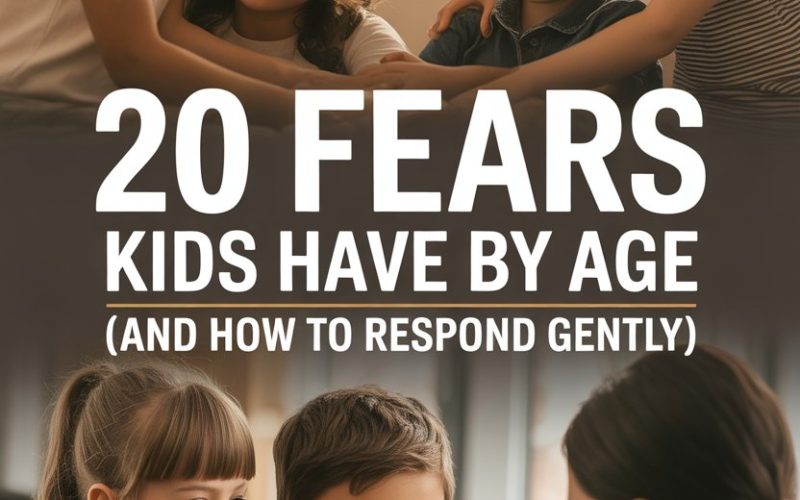Parenting sometimes feels like a mix of amateur detective work and amateur stand‑up comedy: trying to decode your child’s worries, only to step on a Lego en route to comfort them.
Kids are mysterious little creatures, and their fears can seem baffling, hilarious, or even a smidge heartbreaking. But those fears are real—at least to the small person clutching their stuffed bunny like it’s an emotional support animal.
Here’s a tour through 20 fears that crop up during childhood, along with ways to ease worry (for both of you). The best part: most fixes require far less effort than assembling flat‑pack furniture.
1. Babies and the Startle of Newness
Ever noticed how a sudden noise (like a sneeze, or Dad’s attempt at falsetto) can jolt a newborn from zen to full‑blown alarm? That’s the Moro reflex at work. WebMD explains the reflex.
Babies are wired to startle—everything is new. This stage passes quickly, but while it lingers, a gentle touch, soft white noise, and swaddling can settle frazzled nerves.
2. Stranger Danger in Toddlers
Auntie shows up and your toddler morphs into a limpet clinging to your leg. The fear of strangers peaks between 8 months and 2 years. AAP experts call it a healthy milestone.
Offer a warm lap and let them take introductions at their own pace—don’t force hugs or handshakes.
3. Separation Anxiety
Drop‑offs can look like Olympic events: sprints, wrestling, and sometimes an interpretive dance of despair. When children fear being apart, short, predictable goodbyes help (think of it as a calm ritual, not a covert escape).
These AAP‑backed tips can smooth the process. Reading books like The Kissing Hand gives kids a story to hold onto, too.
4. Fear of the Dark
Night lights—possibly invented by desperate parents—exist for a reason. Between ages 2 and 6, kids develop rich imaginations, and with them, monsters under the bed. Psychology Today outlines why.
Instead of dismissing the fear, offer a torch, a security toy, and a ‘monster spray’ made of water (and bravado). Let them check cupboards with you; being involved restores some control.
5. Loud Noises and Thunderstorms
Thunder can make anyone jump, especially little ones who haven’t yet been told the sky isn’t actually falling. Normalize the sound by making a game of counting seconds between lightning and thunder, or by giving the storm a silly name. Verywell Mind explains how reframing loud sounds cuts anxiety.
6. Fear of Animals (Even the Fluffy Ones)
That adorable puppy next door? A toddler’s worst nightmare. Phobias about pets can crop up early. Starting with gentle exposure and coping skills helps kids take teeny steps toward bravery.
7. Toilets and Flushing
It’s hard to potty‑train when the toilet sounds like it’s summoning a spirit every time it flushes. Many preschoolers worry the toilet will eat them—or worse, that something will climb out.
Parents Magazine covers the common fear. Let them flush with you and wave goodbye to the ‘poo convoy’. Books like Everyone Poops keep the giggles flowing.
8. Costumed Characters
Mickey Mouse at Disneyland: adored from afar, terrifying up close. Larger‑than‑life mascots can trigger panic because children struggle to connect the cartoon with the costumed giant looming overhead.
Cuddle up, watch character videos together, and wave from a safe distance before attempting a meeting.
9. Bugs and Creepy Crawlies
Spiders, bees, even butterflies can earn dramatic shrieks. Instead of “Don’t be silly!”, let them learn about bugs through storybooks or safe bug catchers. Knowledge shrinks the fear factor—if only mosquitoes understood boundaries.
10. Medical Fears and Needles
The doctor’s office: where bravery gets tested and stickers are earned through tears. Parents can offer choices (“Which arm?”), distractions, and honesty (“It might pinch, but it will be quick”). AAP advice on pain‑reducing strategies is gold.
11. Fear of Getting Lost
The “what if I can’t find you?” panic can pop up after a big day out or a misplaced parent at the supermarket. Practice naming safe adults (shop staff, teachers) and role‑play what to do. A family bracelet with your contact number builds confidence.
12. Fear of Water and Bath Time Battles
Some children love the bath; others act like you’re tossing them into shark‑infested waters. Bath toys, gentle pouring cups, and praise for even splashing can help. Fun, low‑pressure swimming lessons let them control the pace.
13. Fear of Making Mistakes
Perfectionist tears over a wonky crayon line? Celebrate mistakes as learning moments. Carol Dweck’s work on growth mindsets shows why praising effort builds resilience.
14. Scary Stories and Nightmares
That bedtime book with the too‑creepy witch? Now you’re up at 3 am. Keep pre‑sleep stories gentle; if nightmares strike, listen, cuddle, and reassure. A special night‑light or calm playlist can make bedtime feel safer.
15. Fear of Being Judged
From singing off‑key to wearing the “wrong” backpack, peer worries loom large. Share your own school‑day flops and model self‑kindness; friendships rooted in kindness beat coolness every time.
16. Fear of Death or Loss
Big questions arise after pet losses or scary news. Use truthful, age‑appropriate language, avoid confusing euphemisms, and reassure them of your love and presence.
17. Fear of Failing at School
Break tasks into manageable chunks, set reachable goals, and remind them that learning is a process. Teacher check‑ins and after‑school biscuits help, too.
18. Fear of Being Left Out
Social worries—who to sit with, who’s having a party—appear early. Empathise, role‑play approaches, and listen; sometimes being heard melts half the worry.
19. Fear of Major Changes
New sibling, new house, new school—prepare with stories, pictures, visits, and plenty of honest answers. Keeping familiar routines (same teddy, same bedtime song) grounds them amid upheaval.
20. Fear of Parents Arguing
Raised voices can send kids into panic mode. Strive for calm tones, then reassure them disagreements happen in every family and you’re still a team.
Ongoing conflict? Family check‑ins—or professional help—may be wise.
When Fear Feels Big, You’ve Got This
Children’s fears morph with every growth spurt and life event. With patience, validation, and a dash of silliness, most fade as quickly as they arrive.
And if you defeat the monster under the bed with a spritz of lavender water, that’s a parenting win worth celebrating—preferably with both feet planted safely on the floor.





